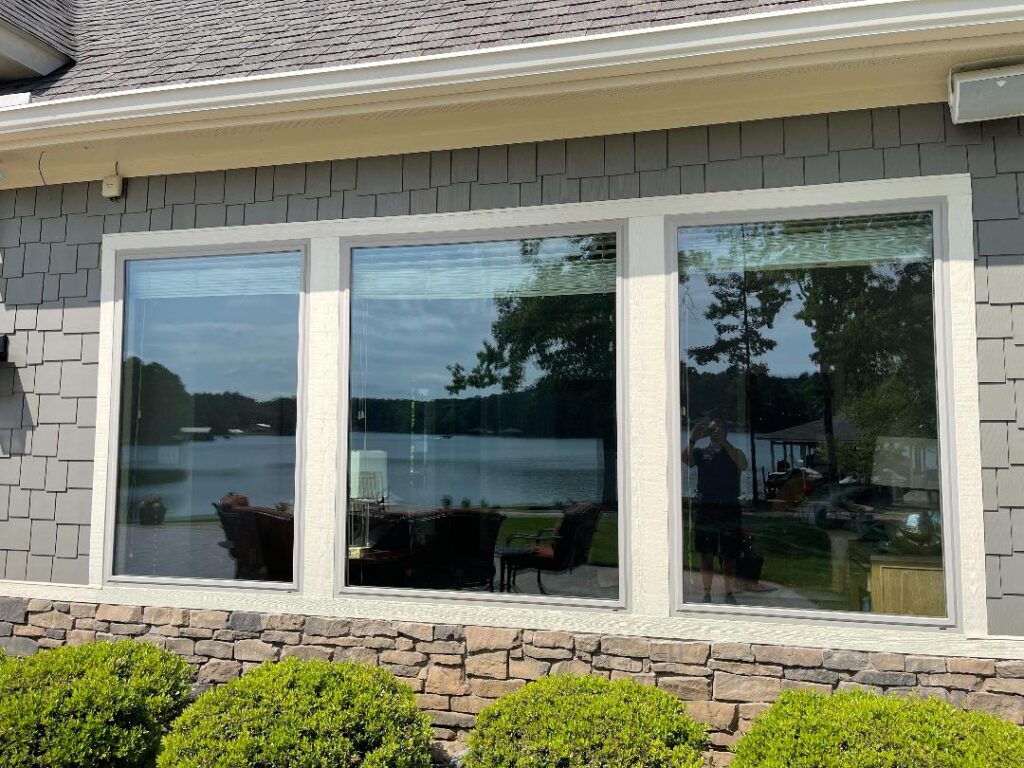Just How Residential Window Tinting Boosts Your Home's Power Efficiency
Residential home window tinting offers a compelling solution for house owners seeking to improve power effectiveness within their living spaces. By using specialized films to home windows, it successfully reduces warmth transfer, thereby supporting indoor temperature levels and reducing the requirement for extreme home heating or air conditioning.
Recognizing Home Window Tinting
Understanding window tinting is vital for home owners looking for to boost both comfort and power performance in their space. Residential Window Tint. Window tinting includes the application of a slim film to the inside or outside surface area of glass home windows. This movie can considerably regulate the amount of sunlight and warmth that gets in a home, thus influencing indoor environment conditions
There are numerous sorts of window tinting movies offered, each with unique residential properties. Dyed movies soak up solar power, while reflective movies deflect it away from the glass surface. Ceramic movies offer a balance of presence and warmth being rejected, making them a prominent selection among property owners. The performance of window tinting is typically gauged by its Visible Light Transmission (VLT) percent, which shows how much light can pass via the movie.
Benefits of Power Efficiency
Home window tinting not just improves visual appeals yet additionally plays a considerable role in boosting energy efficiency within property areas. By decreasing warm transfer via windows, colored movies produce a much more secure indoor environment, which can cause significant decreases in power usage for heating and air conditioning. This energy efficiency equates into lower energy expenses, giving house owners with considerable long-lasting financial savings.

Furthermore, home window tinting improves the comfort of living spaces. By decreasing glare and blocking harmful UV rays, colored home windows develop an even more positive atmosphere, which can lead to boosted well-being for passengers. The protection versus UV rays additionally aids protect furnishings and floor covering from fading, adding to the durability of household items.
How Tinting Works
Tinting films run through a mix of sophisticated products and technologies developed to regulate the amount of solar power going into a home. Mainly made up of polyester, these films often integrate ceramic or metallic bits that reflect and take in heat. This twin ability allows them to significantly reduce the infiltration of ultraviolet (UV) rays and infrared radiation while permitting visible light to travel through.
The performance of home window tinting is gauged by its solar warmth gain coefficient (SHGC), which indicates just how much solar power is sent via the window. Reduced SHGC worths are preferable as they signify better warmth rejection. Additionally, home window colors can feature a selection of shades, published here permitting house owners to personalize their visual choices while enhancing power performance.
Additionally, these movies work as a barrier, avoiding heat loss throughout cooler months by reflecting interior heat back into the space. This thermal insulation click site result matches the cooling benefits gotten during warmer months, contributing to a well balanced interior environment year-round. By taking care of solar power properly, property window tinting not just boosts comfort but likewise plays an essential duty in reducing power consumption and reducing utility costs.
Selecting the Right Color

There are different types of window movies offered, consisting of dyed, metalized, and ceramic. Ceramic films provide excellent heat control without jeopardizing presence and are extremely long lasting, making them a preferred option.
Visible light transmission (VLT) is another important aspect, as it suggests the amount of all-natural light that can go through the colored glass. Homeowners need to pick a tint with a VLT that matches their lights choices while still supplying adequate glow decrease.
Furthermore, evaluating the solar warm gain coefficient (SHGC) can help establish how well a tint can block warm from sunlight. A lower SHGC shows far better heat control, eventually boosting energy efficiency.
Installation and Maintenance Tips
Appropriate installation and maintenance are vital components in maximizing the advantages of domestic window tinting. Specialists additionally utilize specialized methods and tools, which can enhance the sturdiness and effectiveness of the color.
Complying with installment, maintenance is necessary to prolong the life of the home window film. It is advised to wait at the very least 30 days before cleaning the tinted home windows to allow the adhesive to cure totally.
Dealing with these concerns promptly can protect against additional damages and maintain power effectiveness. By adhering to these installment and upkeep suggestions, property owners can ensure their home window tinting proceeds to give significant power cost savings and comfort for years to come.
Verdict
To conclude, residential window tinting works as an effective option for boosting power efficiency within homes. By reducing warmth transfer and obstructing unsafe UV rays, home window movies add to decrease energy intake and enhanced indoor comfort. The selection of suitable tinting materials, together with appropriate installation and maintenance, further takes full advantage of these benefits. Inevitably, home window tinting represents a sustainable investment that not only reduces utility bills but additionally advertises a comfortable living setting throughout the year.
Window tinting entails the application of a thin movie to the inside or exterior surface area of glass windows. By lowering warm transfer via windows, tinted films produce a much more steady interior environment, which can lead to considerable reductions in power usage for home heating and cooling.The performance of home window article source tinting is measured by its solar warm gain coefficient (SHGC), which indicates how much solar energy is transferred via the window. By handling solar energy efficiently, household home window tinting not only boosts convenience however additionally plays a crucial role in minimizing power consumption and lowering energy expenses.
By decreasing heat transfer and obstructing dangerous UV rays, home window films contribute to reduce energy usage and improved interior convenience.